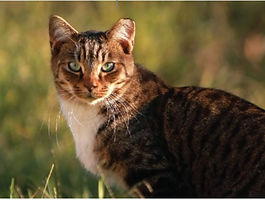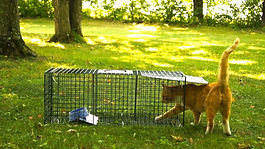


Help cats feel comfortable being near and eating from inside the trap
Place a small amount of food in an un-set trap one meal before trapping. Twist tie the door(s) securely open. Feed the cats as normal in the same location, kibble type, and time of day to avoid suspicion. Monitor the traps while the cats eat to ensure traps are not stolen or a cat is not accidentally trapped without protection from the elements. Cats will each other eating inside the traps and will likely try it as well. When you are ready to trap in the future, withhold food for 12 hours, increasing it by 4-8 hours for each unsuccessful trapping. Always have water available.
For difficult to trap cats text or email the clinic for advanced coaching.
Make the trap more enticing
-
Bits of jarred baby food (without onions)
-
Catnip (smear fresh catnip on trap plate)
-
Make a strong-smelling broth by boiling the “valerian root” in water, and then douse the trap with it.
-
Try other types of bait, such as tuna in oil, mackerel, canned cat food, sardines, anchovies, or cooked chicken without skin.
-
Cats have an extraordinary sense of smell. Traps often smell like humans or cleaning products. Try wiping the trap with fresh catnip or sardine oil.


Use distraction to lure the cat into the trap
Some cats can be guided into the trap while playing with a laser pointer from quite a distance away. Use the laser to emulate the movement of an insect, to draw the cat’s attention inside the trap. Hang a piece of cooked chicken from a string above the trigger plate. The cat will need to step on the plate to reach the chicken. Tie the chicken in the far right corner of the trap so that the cat must “reach” to get the chicken.
Trap Placement
Moving the trap to a nearby, quieter location can raise the cat’s comfort level enough to enter.
Camouflage the trap
Disguise the trap so that it blends in with the surroundings. First, place the trap under a bush, under a leaning piece of wood, or inside a box so the cat is entering a dark space (where they are comfortable). To further disguise the trap, cover the sides with branches, leaves, camouflage material, burlap or other natural materials and even some on the trap floor (leaving the rear view open to see all the way through).
Spring the trap yourself using the water bottle trick
The problem may be a particular cat is suspicious, or it could be that it's the last one in crowd of others who boldly go in ahead of it. The solution is to bypass the trigger/trip plate mechanism of the trap to manually spring the trap. You can do this by propping the trap door up with a full water or soda bottle. Tie a long string around the neck of the bottle then stand some distance away. When your cat of choice finally goes in, yank the string, pulling the bottle away and shutting the trap door. Practice the method at least once so you get the right feel for it, and wait until the cat is up to or past the trip plate before you pull the string.
Watch this short video on the water bottle trick.
